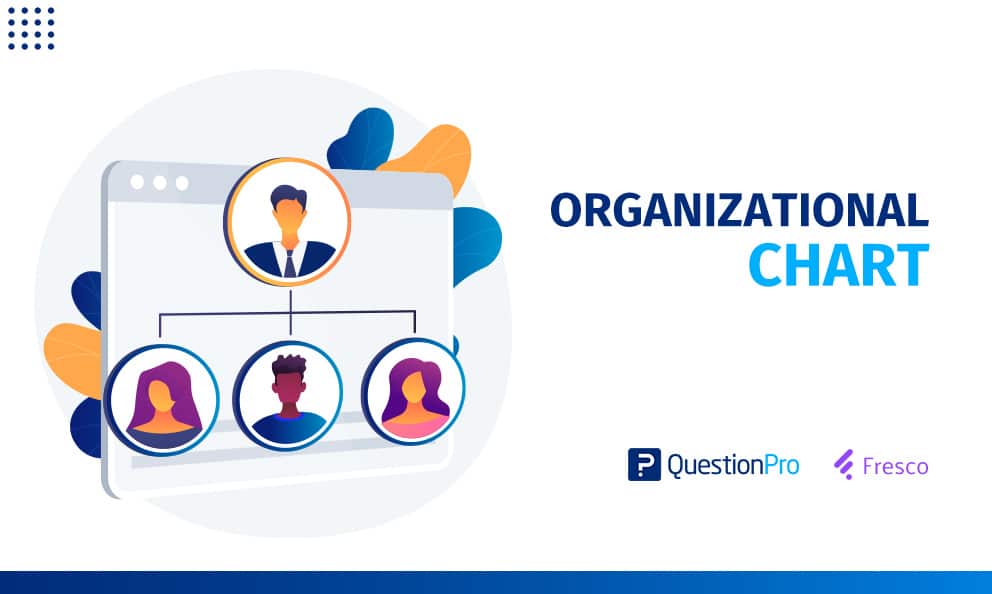 Reading Time: 4 minutes read
Reading Time: 4 minutes read
Understanding how your organization is structured is often an informal initiative, but as you grow your business, it’s important to formalize this structure in an organizational chart.
An organizational chart shows the relationships between people inside an organization. Examples of such relationships include managers to employees, directors to managing directors, the chief executive officer to various departments, and so on.
In this article, we will define what an organizational chart is, walk through why they’re important, and outline the different kinds of organizational chart templates you can use.
What is an organizational chart?
An organizational chart, or org chart, is a template that displays the internal employee structure of a business.
It is meant to highlight the individuals and positions within each part of the organization. These people are represented by boxes and contact information that can be used to easily identify them. Similar to a UML diagram, these elements are linked by elbowed lines.
The overall goal of an organizational chart is to create a visualization of the hierarchy and organizational structure and how the various roles and departments within the business are structured.
An organizational chart is more than just a pretty template, however. Its goal is to both visualize the hierarchical relationship of people within an organization and display important information about their job positions and the overall work culture.
Despite their scope, org charts don’t have to be company-wide and can simply organize a single department or team.
Org charts are helpful, especially during the hiring process, to understand the role that needs to be filled and how that job will relate to the department at large.
Organizational chart benefits
Organizational charts only really serve a single purpose, but within that narrow function, they can benefit your business. Here are some of the biggest benefits of integrating an organizational chart.
Document a reporting structure
Creating an org chart is easy when using a visual collaboration tool, and doing so makes business documentation much more transparent.
Creating a public organizational chart provides your employees with clear references as to where they stand in the organization, who their peers are, who their bosses are, and what their relationship is with everyone else.
This documentation makes reporting and management much easier as everyone has the same shared understanding. As departments grow in size, this becomes increasingly important because there will be an exponential number of relationships and roles to take note of.
Clarify the hiring/Onboarding process
One of the best ways to provide incoming employees with a clear overview of where they fit in the organization is by showing them an org chart. When you have a visual organizational structure that shows everyone’s name, face, position, and contact details, the onboarding process becomes more human, and everyone feels more approachable.
Provides a clear hierarchical organizational structure
Similar to the first point, having a documented business structure is important to display relationships and translate ownership.
When looking at the org chart, no question is the owner of a certain product, the team’s leader, and the department’s head. Having these very clear guidelines makes taking responsibility much easier and provides everyone with a clear endpoint for any reporting they need.
Encourages workplace collaboration
Creating an org chart on an online whiteboard means it doesn’t just have to be a fixed document; it can change and maneuver based on people’s preferences.
This can simply change the design and layout of the board or can reflect an organizational change. Either way, it encourages people to rethink the organizational structure and collaborate on one that is more efficient.
Different types of organizational charts
The hierarchical model of an organization chart is very popular, but it isn’t the only one that exists. The types of organizational charts you create should reflect your company’s management philosophy and organizational structure. Here are three of the most popular org charts out there.

Flat organizational chart
A flat org chart, or horizontal org chart, structures companies on the same plane, indicating increased equality between owners and members. There are two levels to a flat org chart: administrators and workers.
The goal of organization charts is to remove the idea of “middle management” and have responsibility travel straight from an executive to a development team. In flat organizations, the workers are typically granted more responsibility and ownership over their work & decisions.
Matrix organizational structure
The matrix organization charts are built to accommodate more complex business structures, especially ones that don’t fit a strict hierarchical model.
An example of this would be a content creation business where each employee is creating content for a series of different managers in different locations. Org charts are structured purposefully to allow workers to have multiple managers and managers to have multiple workers.
Hierarchical organizational chart
The hierarchical org charts are the most familiar and common, and their organizational structure is derived directly from the business hierarchy. Not every business will fit in this model, but this will usually do the trick, considering that most hire positions and work towards a linear organization model.
Division organizational charts
The divisional chart is an org chart organized by additional factors besides hierarchy. It could be location, age, departments, interests, etc. It is a way to subdivide a company into multiple different sections, each with its own unique elements.
Conclusion
Org charts are not always necessary, especially for smaller businesses, but as your company grows, they can provide some essential assets that are hard to come by. If you want to learn how to build your own org chart, make sure you check out Fresco.
If you’re curious to learn more about how QuestionPro’s Workforce tools help organizations manage their workplace cultures, connect with one of our experts and create org charts in minutes. Simplify the process of visualizing your company’s structure with our user-friendly org chart creation tool. You can also sign up and get a feel of the platform.




















